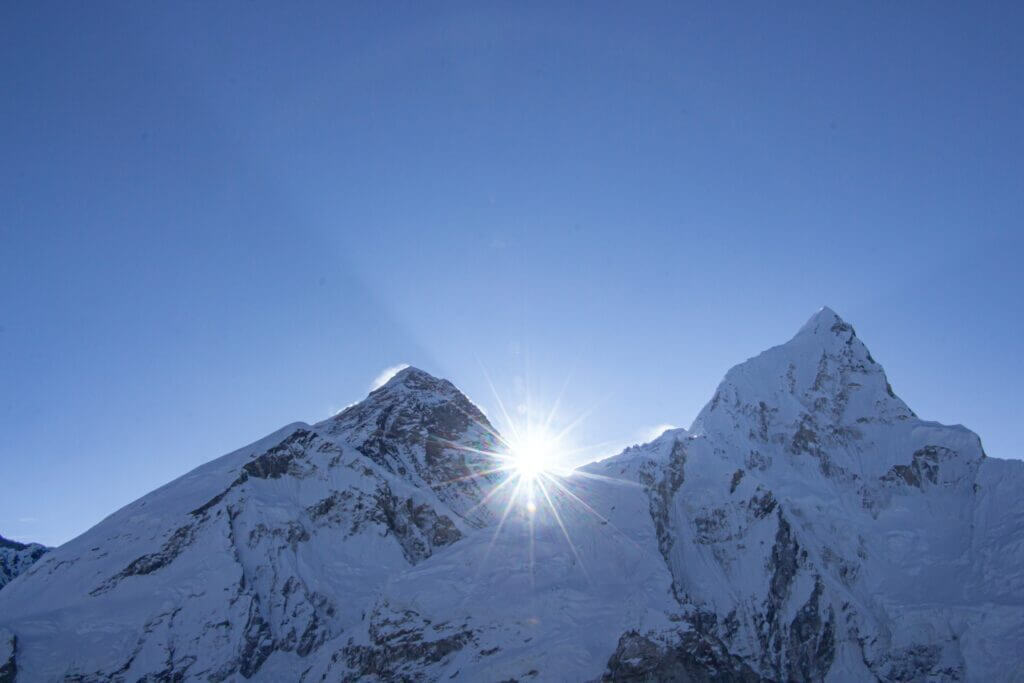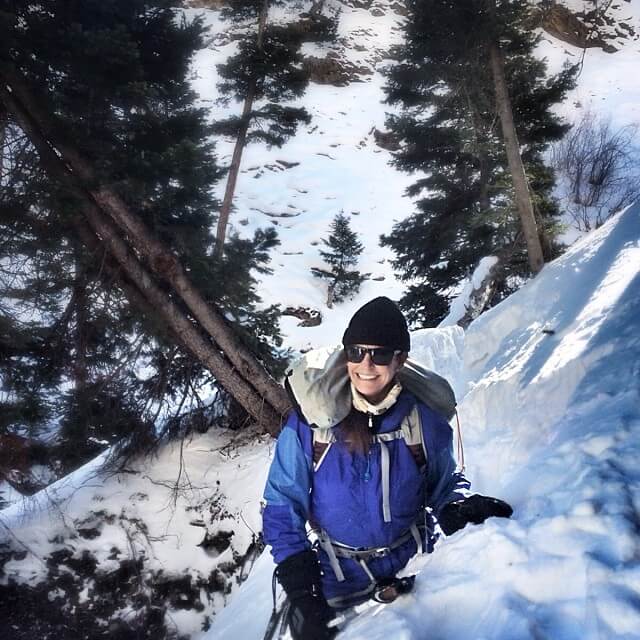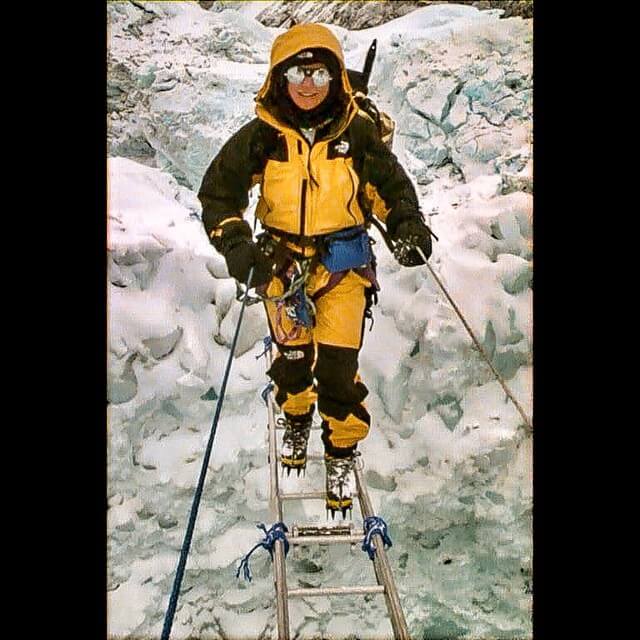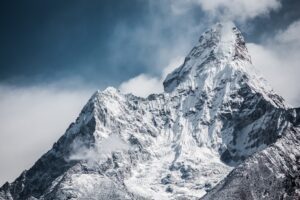Conquering Mount Everest is no ordinary feat. Its treacherous terrain, extreme altitude, and perilous conditions make it the ultimate challenge for even the most seasoned mountaineers.
Sandy Hill Pittman beat the odds. She made mountaineering history by reaching Everest’s summit. On a key day, she stood on the highest peak in the world. This happened at roughly 2:30 P.M. on May 10. She was 29,028 feet above sea level.
It was a moment she had tirelessly pursued throughout her lifetime, a dream transformed into a tangible reality. Despite the inherent dangers and the ominous label of the “Death Zone” looming above 26,000 feet, Sandy’s indomitable spirit and unwavering determination propelled her forward. As she stood on that majestic summit, she knew that her journey was not only a personal triumph but a testament to the extraordinary resilience of the human spirit.
May 10, 1996, also marked history as the “1996 Everest Disaster”.

From High Peaks to High Society: The Adventurous Journey of Sandy Hill Pittman
Sandy Hill: A Formidable Fusion of High Society and High Altitude
Sandra Hill, also known as Sandy, is from Los Gatos, California. She’s an interesting figure, combining high society, mountain climbing, and fashion. She was born on April 12, 1955. Sandy’s achievements are diverse. They include major mountaineering feats, writing, and significant fashion industry contributions.

The 34th woman to reach Mount Everest summit and the second American woman to conquer the Seven Summits, Sandy stands as a prominent figure in the world of mountaineering. Her indomitable spirit was displayed vividly as she survived the infamous 1996 Mount Everest disaster, further cementing her reputation as a formidable adventure.
A Remarkable Career Journey
Sandy was raised around her father’s thriving portable toilet rental business. This instilled a strong work ethic, which showed in her successful career. She completed her education at UCLA. This led her to New York. Here, she started her career as a buyer for Bonwit Teller, which has since closed.
Following a fortuitous encounter with a Mademoiselle editor, Sandy transitioned into the world of fashion journalism, eventually becoming the Beauty Editor of Brides magazine. Her innovative spirit led her to serve as president of a division of RJR Nabisco, “In Fashion,” which allowed her to contribute significantly to the fashion television industry with groundbreaking shows like Fashion America – a pioneer in its fusion of fashion commentary, runway footage, and videos. Her influence also extended to the pages of Vogue and Condé Nast Traveler as a contributing editor, while her insightful feature articles graced other publications.
A Life of Adventure, Love, and High Society
Sandy’s personal life was no less eventful. Her first marriage to Jerry Solomon, a figure in the sports business and a Columbia graduate student at the time, was brief, ending in divorce before she reached 23. Solomon would later gain fame as the husband of figure skater Nancy Kerrigan. A new chapter opened for Sandy in July 1979 when she married Robert Pittman, the MTV co-founder and then Program Director of WNBC in New York. The union produced a son, Robert T. “Bo” Pittman, but ultimately ended in 1997, with a substantial settlement of $20 million going to Sandy.
During her famed Everest expedition in 1996, she met snowboarder Stephen Koch, a relationship that led to them cohabiting in New York until 1997.
Sandy’s thirst for knowledge prompted her to further her education in 1998 at the Columbia Graduate School of Architecture, Planning, and Preservation. There, she dove into the nuances of architectural preservation and restoration, graduating successfully in 2000.
The new millennium saw Sandy marrying Thomas Dittmer, a commodities trader, in April 2001. They bought a scenic ranch and vineyard in the Santa Ynez Valley. However, by 2008, they faced a contentious divorce and failed efforts to cancel their prenup. Despite hardships, Sandy still shows an adventurous spirit. She scales high peaks and moves within high society and fashion circles.
Unyielding Heights: Sandy Hill’s Quest for the Seven Summits and the Triumph of Everest
Scaling Heights: Sandy Hill’s Journey Through the Seven Summits
A deeply ingrained spirit of adventure began blossoming within Sandy Hill during her teenage years when she first challenged herself against the rugged contours of Disappointment Peak in the Teton Range at the tender age of 13. This maiden summit sparked a fiery passion within her that was to burn intensely over the decades. A testament to this unwavering passion was her quest, initiated in 1992, to etch her name in mountaineering history as the first American woman to conquer the Seven Summits—the loftiest peaks gracing each of the seven continents.
With a blend of determination, tenacity, and courage, Sandy embarked on this formidable journey. Her mountaineering exploits led her to the windswept heights of Aconcagua in 1992, and later that year, she triumphed over the rugged terrains of Denali. The next year, she subdued the icy expanses of Vinson Massif, Mount Elbrus, and Mount Kilimanjaro. The sunburnt summit of Mount Kosciuszko fell to her in 1994, and Puncak Jaya surrendered to her indomitable spirit a year later in 1995.

However, the crown jewel of her mountaineering journey was her ascent of Mount Everest in 1996. Despite the immense challenges it posed, Sandy’s resolve remained unbroken. Scaling this gargantuan peak, she proudly became the second American woman to surmount the Seven Summits, following in the footsteps of the revered Mary “Dolly” Lefever.
Perseverance at Peak: Unyielding Journey to Mount Everest’s Summit
Sandy’s relationship with Mount Everest, often revered as the ultimate mountaineering challenge, was one of dogged persistence. Her first attempt in 1993 brought her to an impressive 23,500 feet, guided along the well-trodden South Col route. A special custom-made cross necklace, crafted by the skilled hands of jeweller Barry Kieselstein-Cord, adorned her neck during the expedition, intended as an offering for the Everest summit. However, the summit eluded her, and the necklace remained unburied.
Undeterred, Sandy gathered momentum for a second Everest expedition in 1994. This time, she raised a whopping $250,000 from corporate sponsor Chesebrough-Ponds and aimed to conquer the challenging Kangshung Face. Alongside her were her film production partner, filmmaker David Breashears, and acclaimed climbers Alex Lowe, Barry Blanchard, and Steve Swenson. However, a menacing avalanche threat looming above 25,000 feet thwarted their ambitions.
Even with setbacks, Sandy kept her dream alive. Her persistence paid off in 1996 when she reached Mount Everest’s summit. Her bold, enduring mountaineering career shows her love for challenging limits. This story unfolds against the backdrop of the world’s tallest mountains.
Unveiling the Spirit: Sandy Hill Pittman’s Journey from Socialite to Everest Adventurer
From Socialite to Mountaineer: Sandy Hill Pittman’s Transformation into a Modern-Day Adventurer
At 41, Sandy Hill Pittman, a former socialite turned explorer, began a significant journey. Its importance surpassed the high $65,000 cost of an Everest expedition. Tired of a glamorous life tied to Bob Pittman, MTV’s creator, she started to tap into her hidden mountaineering passion. This passion sparked in her childhood, became a lively, public display of her unyielding spirit and ambition.
Sandy’s former hobbies, such as Himalayan treks, Kenya’s vast plains gallops, and Arctic Circle kayaking, turned into intense passions. They were more than just hobbies – they shaped her purpose, crafting her into a modern Amelia Earhart. She chose Gore-Tex over La Perla lingerie and wild lands over Bergdorf’s polished floors. Nina Griscom, a friend, saw her as inspirational and limit-pushing. However, others noted her flair for showmanship with both respect and doubt.
Conquering Heights: Sandy Hill Pittman’s Third Attempt to Summit Everest Amid Personal Trials
Mount Everest represented the grand culmination of Pittman’s dream to become the third woman to conquer the Seven Summits, a feat that would ink the last chapter of her upcoming book, “Summits of My Soul”. The achievement would draw her closer to her ultimate goal: to be a renowned sportswoman with a significant media footprint, essentially becoming the Martha Stewart of mountaineering.
Sandy’s preparation phase involved both intense training and high-profile publicity. She showed relentless determination by repeatedly climbing 26 flights of stairs to her apartment. She did this eight times a day. Sandy was featured in Vogue wearing her climbing gear. She also got a deal with NBC to share her digital Everest diary. Society writer Billy Norwich threw her a farewell party at Nell’s. Notable guests included André Balazs, Bianca Jagger, and Calvin Klein. Sandy showed up in full climbing gear, crampons, and an ice axe included. To boost her self-promotion, she appeared on postcards with her web address. These invited everyone to follow her virtual climb to Everest.
The stakes could not have been higher for Pittman as she embarked on her third Everest expedition. The journey exacted a heavy toll, draining her finances and straining her 16-year-long marriage to the breaking point. Her husband had moved out in October, leaving Pittman in emotional turmoil. She was torn between her responsibility towards her 12-year-old son, Bo, and her relentless ambition to scale Everest, particularly during the throes of a divorce. Yet, when an opening in an expedition team appeared, she seized the opportunity. Entrusting Bo to her mother’s care, she once again stood before the mighty Everest, her eyes firmly set on its peak.
Summiting the Ultimate Challenge
Sandy Hill Pittman joined an expedition led by Scott Fischer. He was an experienced guide and co-founder of Mountain Madness, a trekking company in Seattle. Fischer, who turned 40 during high-altitude adventures, planned to lead a team on Everest. This team included eight clients, three guides, and seven Sherpas. However, two clients dropped out. The remaining team planned to take the Southeast Route. Fischer affectionately called this route “the yellow brick road”. It attracted wealthy climbers despite a grim statistic: Everest claimed 142 lives for every 600 successful climbs.
The team spent a month acclimatizing at Base Camp. It was located at a high altitude of 17,600 feet. Here, amidst a tent city on the rugged mountain terrain, they prepared for the tough climb. They tested their stamina by hiking to higher spots. This also got their lungs ready for the thin air ahead. During this time, they cleaned up the mountain. They collected over two tons of litter left by countless previous trekkers to Everest’s base.
As for Pittman, she was described as a “competent climber” by Mountain Madness. Her performance during this preparatory phase was commendable; she not only held her own but also contributed to the team’s efforts, corroborated by Fischer’s expedition reports. Indeed, her vast experience in tackling towering peaks and the wilderness proved to be a cut above some of the other climbers embarking on similar quests.
Against the Elements: the 1996 Everest Disaster
Everest Assault
Sandy Pittman survived the notorious 1996 Mount Everest disaster. She joined Scott Fischer’s Mountain Madness team during her third attempt on the icy mountain. NBC Interactive Media noticed her, streaming her Base Camp reports to American schoolchildren. This ground-breaking project used advanced tech. It included a tough laptop and a heavy 20-pound satphone, which failed at Camp IV’s high altitude. The project was named ‘NBC Everest Assault.’
The summit beckoned on May 10, 1996, and around 2:30 pm, Hill’s perseverance finally bore fruit. A series of jubilant high-fives echoed atop the peak before they began their precarious descent of the infamous Hillary Step. Lopsang Jangbu Sherpa had guided Hill, securing her to a short rope for the initial five to six gruelling hours of their ascent. As daylight dwindled into the frigid night, Neil Beidleman, a guide from Mountain Madness, escorted Hill and her fellow climbers, including Tim Madsen and Charlotte Fox, down Hillary Step. This journey spanned a gruelling eighteen hours.
Mount Everest Descent: A Tale of Survival and Resilience
The descent was full of difficulties. At one point, Hill’s crampons got tangled in the ropes. Hill later gave herself a shot of dexamethasone. Then Beidleman asked Lene Gammelgaard to exchange her oxygen tank with Hill’s nearly empty one. They slid down fixed lines to the South Col. Here, they met Mike Groom, a guide from Adventure Consultants, and his clients Yasuko Namba and Beck Weathers. They also met Klev Schoening from Mountain Madness and two Sherpas.
The tempestuous storm that had gathered left them huddled in the snow lost and disoriented. Midnight saw the storm relent, revealing a glimmering tapestry of stars and instilling a renewed sense of hope in Beidleman, Schoening, Gammelgaard, and Groom. Leaving behind their incapacitated teammates, they valiantly embarked towards Camp IV, seeking help. Upon reaching the camp, they alerted Anatoli Boukreev, another Mountain Madness guide, who journeyed to the group’s location. Boukreev, battling his own fatigue, assisted Hill and Fox and left Madsen with Hill. In an awe-inspiring feat, Weathers managed to awake from his unconscious state and climb to Camp IV, a testament to human resilience.
After the Storm: Navigating the Aftermath of the 1996 Everest Disaster
The ensuing days saw the team navigating treacherous paths down to Camp III and Camp II, amidst the echoes of a past tragedy and fresh hazards. Finally, on May 13, their weary feet touched the relatively safe grounds of Base Camp. The next day, Hill, Fox, and Madsen began their journey to Pheriche, from where they took a helicopter to Kathmandu.
The fateful night claimed eight lives, with seven belonging to other expeditions. The disaster reverberated across media channels, with articles, interviews, and Jon Krakauer‘s gripping account, “Into Thin Air,” scrutinizing the commercialization of Everest. Amidst the scrutiny, Hill remained resilient, asserting her expertise and team spirit in various interviews. High-profile before the climb, she felt she was misconstrued as a privileged New Yorker, an easy villain in the dramatic Everest narrative.
Scaling the Heights: Sandy Hill Pittman’s Everest Journey in Media and Memory
During a candid exchange with Outside magazine in 2006, Sandy Hill staunchly stood in defence of Anatoli Boukreev’s decision-making amidst the Everest calamity. Hill voiced her critique against certain media outlets and journalists who depicted the 1996 disaster in their own narrative, labelling the portrayals as biased, sensationalist, and exaggerated, crossing the boundaries into the realm of thrilling fiction rather than maintaining journalistic integrity.
Undeterred by the criticisms, Boukreev was honoured with an award for heroism by The Alpine Club, a testament to his courage in the face of overwhelming adversity. To provide his own perspective of the tragic event, Boukreev penned ‘The Climb: Tragic Ambitions on Everest’ in 1997. This compelling narrative served as a counterpoint to Krakauer’s depiction, which had painted Boukreev, Hill, and a few others with the broad brush of blame for the Everest disaster.
Hill’s personal recollections found their way to the pages of Vogue’s August 1997 issue. Her article traversed the contours of her vibrant history as a climber, exploring her deep-seated passion for mountaineering, kindled during her early years. She detailed her trials and triumphs while scaling the Seven Summits and unveiled the tangible dangers she braved during her final Everest expedition.
“Into Thin Air: Death on Everest” (1997) (the TV movie) drew inspiration from Krakauer’s book, featuring Pamela Gien in the role of Sandy Hill. Subsequently, in the PBS Frontline documentary ‘Storm Over Everest’ (2008), David Breashears conducted a probing interview with Hill. This hard-hitting documentary aired on May 13, 2008.
The feature film ‘Everest’ (2015) took the portrayal of Hill’s character a notch higher, with Vanessa Kirby infusing life into Hill’s persona. This ambitious cinematic undertaking echoed Hill’s determination and resilience amidst the harsh conditions on the planet’s highest peak.


